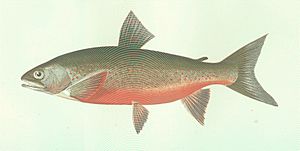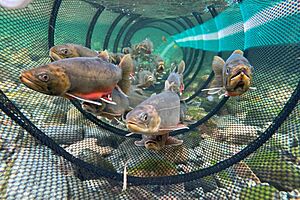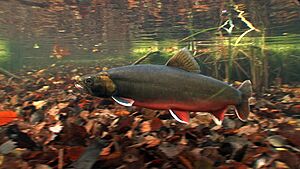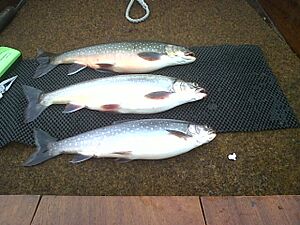Windermere charr facts for kids
Quick facts for kids Windermere charr |
|
|---|---|
 |
|
| Conservation status | |
| Scientific classification |
The Windermere charr, also known as Salvelinus willughbii or Willoughby's charr, is a type of cold-water fish. It belongs to the Salmonidae family, which includes salmon and trout. This fish is named after Francis Willughby.
Windermere charr are special because they are "leftovers" from the last ice age. They got trapped in lakes in Cumbria, England, as the ice melted. They are a subspecies of Arctic charr. You can find them in several lakes in the Lake District in Cumbria. These lakes include Windermere, Coniston Water, Wast Water, Ennerdale Water, Buttermere, Crummock Water, and Lowes Water. The Windermere charr is listed as an endangered species. This is mainly due to warmer water, less oxygen, and too much fishing in Lake Windermere.
Contents
What Does the Windermere Charr Look Like?
Windermere charr change their look depending on the season. In autumn and winter, they have long bodies. Their top side is dark, with grey in the middle. Their belly is white, with a muddy pink color. They have light pink spots along their body. Their back and tail fins are dark. Their other fins are muddy pink. Their head is dark on top and silver on the cheeks.
In spring and summer, their colors get lighter. Their back turns blue or even olive green. The colors on their belly and fins become brighter. Adult male charr have a pointy head. Females have a more rounded head. The lower part of their mouth is white. Sometimes, the upper part is dark.
Most adult Windermere charr are about 10 to 12 inches long. Some can grow up to 18 inches. Males usually weigh between 9 and 14 ounces. Females are a bit lighter, from 8 to 13 ounces. The biggest one ever caught in the Lake District weighed 1 pound 11 ounces in 1973. There are also "dwarf" charr. These are smaller, reaching about 7.5 to 8.5 inches. Dwarf charr weigh about 2.5 to 4.2 ounces.
Where Do Windermere Charr Live?
This special type of charr lives in several lakes in the Lake District, Cumbria, England. Lakes where they are known to live include: Lake Windermere, Coniston Water, Wast Water, Ennerdale Water, Buttermere, Crummock Water, and Loweswater. In the past, Windermere charr also lived in Goat's Water. However, they are now thought to be gone from that lake.
What Do Windermere Charr Eat?
Windermere charr mostly eat tiny living things in the water. These include small plankton, copepods, and other small water creatures. They also eat invertebrates that live on the lake bottom. In late spring and summer, they mainly eat small insects and other tiny things floating in the water. During their spawning season in winter and early spring, charr eggs are also a common food source for them.
How Do Windermere Charr Reproduce?
Windermere charr look for rocky areas to lay their eggs. They prefer spots with stones about the size of acorns or larger. The depth and time of year for spawning depend on the charr population in each lake.
Early in the spawning season, male charr move into a chosen area. They wait for females to arrive. Once a female enters the spawning ground, she starts to dig. She uses her tail to move the gravel and make a small dip. After she finds a male mate and digs a nest, they spawn together. The female lays her eggs in the nest, and the male fertilizes them. Then, the female uses her tail again to cover the eggs with gravel. Males often stay near the nests longer, probably to protect the eggs.
Spawning in Windermere
Lake Windermere has two groups of charr that spawn at different times. Some spawn in autumn, mainly in November. Others spawn in springtime, usually in February. In autumn, most nests are in shallow areas (3–12 feet deep) in the lake or the River Brathay. In springtime, spawning happens in the main lake in deeper water (50–70 feet deep).
Spawning in Coniston Water
In Coniston Water, charr mostly spawn in March. They do this in water that is about 40 feet deep.
Spawning in Ennerdale Water
Spawning in Ennerdale Water happens in early November. It takes place in the River Liza, which connects to the main lake. The exact depth is not known.
Spawning in Haweswater, Buttermere, Crummock Water
In these lakes, charr spawn in January. They do this in the main parts of the lakes. It is thought to be in water ranging from 30 to 60 feet deep.
Protecting the Windermere Charr
Conservation Status
The Windermere charr (also called Willoughby's Charr) is currently listed as endangered on the IUCN Red List. This means they are at high risk of disappearing forever.
What's Being Done to Help?
Lower oxygen levels and warmer water are big threats to Windermere charr. In Windermere, waste from sewage plants used to go into the lake. This caused low oxygen levels and lots of algae to grow. Since 1992, special treatments have been used at wastewater plants around Lake Windermere to remove phosphate. This helps stop algae from growing too much. However, water running off the land still brings in phosphates. Efforts are being made to control this runoff.
In Ennerdale Water, a man-made pipe bridge blocked the River Liza. This stopped the right size of gravel from reaching the charr's spawning grounds near the lake. Also, water in the river became too acidic. This was due to leaves from non-native trees falling into the water. Recently, people have worked to help the charr in Ennerdale Water. They removed the pipe bridge and planted native trees around the River Liza.
Invasive Species
New species of fish brought into the Lake District waters are causing problems. These "invasive species" compete with the native charr for food. For example, common roach eat the same food as Windermere charr. As roach populations grow, they become a bigger problem for the charr.
Fishing for Charr
In recent years, most fishing for charr in the Lake District uses traditional hand-lining or rod and reel. Fishermen have reported catching fewer charr as their numbers continue to drop. Commercial fishing with nets started as early as the late 1600s. However, it was stopped in the early 1900s because people worried about the charr population shrinking.
Images for kids









